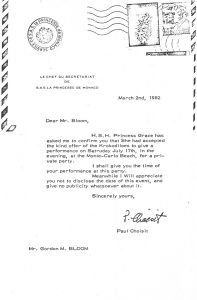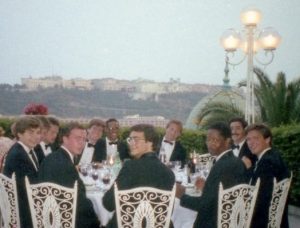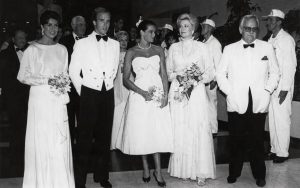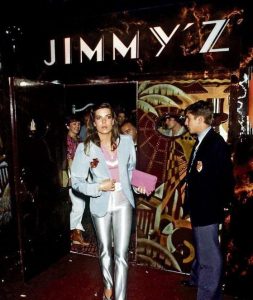Princess Grace of Monaco, HK 1982 (1929-1982)
The Kroks gained an audience to sing for Princess Grace in Monaco on July 17, 1982 at the Monte-Carlo Beach Club.
The Kroks had secured a stay at the Hermitage, a landmark hotel nearby, in exchange for performing at Les Terrasses. One of the perks of that stay was that they had some wonderful dinners on the fantastic terrace overlooking Port Hercules with the palace in the background.
The day before the big event, we headed over for our sound check and a small private audience with Princess Grace. Our group included George Overholser (Music Director), Gordon Bloom (General Manager), Steve Latham (Assistant Director), Bill Adams, James Bundy, Frank Chaiken, Mark Clinton, Rex Dean, Bryan Simmons, Bill Thompson, Tom Uskali, and Tom Walsh. We were assembled by the pool to wait for her arrival.
Several cars pulled up – Princess Grace and her entourage. There were six or seven stations arranged in an oval, designed to give her a preview of the party’ arrangements. She visited each one in sequence, providing nods of approval. One of the stations had a man that turned on a light switch to show off the festive little bulbs. Another had a man wearing a chef’s hat with a plate of food. When our time came to be inspected, she walked toward us with her entourage in tow. Finally, as she reached us, she said “Hi boys, I’m Princess Grace.” Just like that, as if she were your new home room teacher introducing herself on the first day of school. We made Princess Grace an Honorary Krok immediately!
The next evening, it was a lovely, amazing summer party outdoors with H.S.H. Princess Grace and Prince Rainier, and their children Caroline & Albert (close to our age, a little older) and Stephanie (a few years younger) and their friends.
The party was reminiscent of the Belle Epoque, but updated for the 1980s, with European royalty, American High Society, and a dash of Hollywood and the entertainment world. We were treated as much as guests as performers. We arrived and were greeted in receiving line fashion by the family. We had assigned seating and were seated right along with her many royal friends. Gordon commented to Princess Grace that it was wonderful that she had engaged the Lester Lanin Orchestra and she said that it was very hard to find an orchestra quite like them in Europe so she simply flew them in from New York. She communicated to us that Americans (like the Kroks!) can have an energy, vitality and originality that was important and appreciated in older, stuffier Europe. It was our brief social savoir faire life lesson from an extraordinary American actress and Alfred Hitchcock film star who had become a beloved European Princess.
After our dinner by the pool the party was full on, but was a bit like any party that is chaperoned by parents. The Grimaldi’s sat with their friends at a long table not too far from the dance floor where they could watch everyone just like parents at a kid’s party. Princess Caroline, who was awaiting an annulment of her marriage from the Pope, sat with the “grown-ups.” At some point, one of Grace’s Hollywood friends, who had been a producer of the TV show Bewitched, came over and said “the Princess would like to invite you over to her table for a beer.” We went over and Rex kept asking questions like “how early did you have to get up when you were working as an actress?” Eventually, the dance hit “Could be that it’s Just an Illusion” came on and Caroline insisted that we dance.
On the way from the dinner to Jimmy’z Monte-Carlo Night Club, the Studio 54 of Monaco, Rex told Princess Grace that he’d always wanted to sing “Stardust” for someone who knew Sinatra. He meant to sing to to her quietly as we walked, but she insisted on gathering thirty or forty friends, including the Prince and a sculptor named Gantt Gaither. The group seemed to enjoy the song and several said they’d known Hoagy Carmichael and Sinatra as well.
The party went on into the wee small hours of the morning and then at some point we enjoyed the Riviera Italiana custom of having “a late-night spaghetti.” One funny incident was that James’ chair leg was firmly set upon Princess Grace’s dress, so when she tried to stand up after joining us at the table where we were eating the early morning pasta, she fell heavily back into her seat! She was very kind about it.
We were chatting with many interesting people, including Farrah Fawcett and Ryan O’Neal. At one point Mark was having a fabulous dance with Princess Caroline, who was loving trying to keep up with Mark who is an exceptional dancer! Bill also had a dance with her.
Although our trip to Monaco was filled with many impressive moments (our radio interview, our invitation to sing on Khashoggi’s yacht, the Nabila), our evening with Princess Grace and family was the absolute highlight!
– The collected recollections of Gordon Bloom, James Bundy, Rex Dean, George Overholser, Bryan Simmons, and Bill Thompson
Obituary: Princess Grace is Dead After Riviera Car Crash
Princess Grace of Monaco, whose stately beauty and reserve gave her enduring Hollywood stardom even long after she ended her film career, died yesterday in Monte Carlo of injuries suffered when her car plunged off a mountain road Monday. She was 52 years old.
The Princess, the former Grace Kelly, died of a cerebral hemorrhage, a palace spokesman said in Monaco. Princess Grace wa driving her British Rover 3500 on a snaking road at Cap-d’Ail in the Cote d’Azur region when she lost control and plunged down a 45-foot embankment. The car burst into flames, and the Princess suffered multiple fractures, including a broken thigh bone, collarbone and ribs.
Initial reports gave no sense that her life was in jeopardy. But a Monaco Government announcement yesterday said that her health had ”deteriorated during the night.”
”At the end of the day all therapeutic possibilities had been exceeded,” the announcement said. With her in the car was Stephanie, 17, her youngest child by Prince Rainier III of Monaco. Stephanie was under observation at a hospital where she had been treated for shock and bruises.
Reagan Praises ‘Gentle Lady’
Princess Grace’s death brought expressions of grief from former Hollywood colleagues and from residents of her hometown, Philadelphia. President Reagan called her ”a compassionate and gentle lady.” In Philadelphia, a spokesman for John Cardinal Krol said the Cardinal, who was a close friend, would offer a memorial mass for her at noon Friday.
Alfred Hitchcock, who directed Grace Kelly in three films and was certainly in a position to judge, once said she had ”sexual elegance.” And it was that very elegance that probably made its most lasting impression on movie audiences of the 1950’s.
Whether playing the heiress in ”To Catch a Thief” or the Quaker pacifist in ”High Noon” or the amusedly detached career girl – a term still in vogue when ”Rear Window” was made – Grace Kelly carried herself with straight back and clipped-voice self-assurance. Yet just beneath the frosty exterior lay a sensuality and warmth that cracked the formidable reserve.
It was this delicate balance of contrasts that helped give her legendary status – a remarkable achievement for an actress whose career encompassed only 11 films. She made more of that small portfolio than actors who lasted in Hollywood many more decades. Twice she was nominated for an Academy Award, and once she won it, for her 1954 performance in ”The Country Girl.” There was a certain irony in the fact that the Oscar came, not for her portrayal of yet another detached beauty but of a frumpy harridan, desperate in her unhappy marriage.
By then the range of her talent was obvious, and Miss Kelly was constantly in demand for a variety of screen roles. But just as swiftly as her film career blossomed, it came to an abrupt end in 1956 when she married Prince Rainier of Monaco, the tiny principality on the French Riviera.
The year before she was in Cannes filming ”To Catch a Thief” with Cary Grant and it was at the film festival there that she met the Prince, a member of the Grimaldis, Europe’s oldest royal family. At first, their friendship seemed little more than a good story for the gossip columns – Hollywood star meets royalty and both drive off into a gold and purple Mediterranean sunset.
But before long it became clear that there was more than that to this relationship. He went to Philadelphia to spend a Christmas holiday with her family. She went to Monte Carlo to visit him in his 200-room pink palazzo.
Couple Marry in Cathedral
On April 18, 1956, shortly after she completed the movie ”High Society,” they were married in the Cathedral of St. Nicholas in Monaco. It was a media event of such staggering proportion that Miss Kelly, now Princess Grace, later suggested that she and the Prince should have been awarded battle ribbons for all the fighting that was required for them to push through the crowds. pick up first add
With marriage, she abandoned acting. The effect, as time passed, was to burnish her film career in public memory. Early on in her marriage she received many offers of movie roles but she kept turning them down. Some of her former colleagues in Hollywood could not understand why, but Gary Cooper, her co-star in ”High Noon,” shrugged off the idea of a Kelly comeback. ”Why should she?” he said. ”She’s moved from an artificial stage to a real one.”
Her Duties Predominate
Periodically, there would be reports that she was indeed about to resume her career but nothing ever came of them. ”Here I have my obligations and duties as a princess and mother,” she said. ”One cannot do everything.”
Her life as Princess of Monaco was obviously enhanced by privilege but also circumscribed by duty. She became a supporter of charities and cultural events. Much of her time was devoted to her three children, the oldest of whom, Princess Caroline, was born in 1957. In recent years, Princess Caroline outranked her mother as a source of fascination for curiosity-seekers, mostly as a result of her marriage to and then divorce from Phillipe Junot, a French businessman whom some people liked to describe as ”the playboy next door.”
In recent years Princess Grace made occasional forays into show business, never for very long and usually to read prose or poetry for one benefit or another. She did make one movie, sort of, five years ago – a delicate documentary about the Kirov Ballet school in Leningrad called ”The Children of Theater Street.” The Princess narrated the film and appeared on screen briefly. But when, inevitably, the question arose whether she would plunge fully into work once again, she smiled at her interviewer and said, ”Oh, no, not again.”
”I’m getting older, too, dear,” she added. ”The only one who isn’t is Cary Grant.”
Safely Short of Iciness
A lot of people would have said the same thing about her. Always, she had a beauty that came perilously close to iciness but managed to stop safely short. Scratch that coating of ice – and most of her directors did – and exposed just beneath the surface was, variously, warmth, intelligence and sexuality. She could even be whimsical, in a detached fashion, a quality that she showed to advantage in ”Rear Window,” in which she was the girlfriend of James Stewart, a photographer with a broken leg who witnesses a murder across the courtyard from his apartment.
Perhaps no one caught the inherent sensuality more than Hitchcock, who said in later interviews that this was no mean trick, given Miss Kelly’s reserve. A good example of the passion was a love scene with Cary Grant in ”To Catch a Thief.” These days, a younger generation might regard the scene as coy, but the sight of Grant and Kelly embracing while fireworks exploded at a Cannes carnival in the background was enough to send the blood of more than a few moviegoers racing.
For herself, Miss Kelly was never comfortable with her popular image as an ice queen. ”I’m not an extrovert – but I’m not unfriendly either,” she told an interviewer early in 1955. ”I’m not the exuberant type, but I don’t like to read that I’m cold and distant. I don’t think I am.”
The patrician manner, suggesting English roots, did not accurately reflect her Philadelphia background.
Father Acquires Riches
Princess Grace was born Nov. 12, 1929, into a family that in later years would be compared frequently to the Kennedys – rich, attractive and Irish-Catholic. The difference, however, was that the Kennedys were from Boston, a kind of Irish-Catholic citadel; the Kellys were from Philadelphia, a city in which few Irish had become prominent. John Brendan Kelly, Princess Grace’s father, was one of the first.
Mr. Kelly, the son of an immigrant, worked as a bricklayer. He was also a local sculls champion. His 1920 entry into the English Diamond Sculls at the Henley Regatta was refused, however, because he ”worked with his hands” -a manual laborer. Supposedly, he immediately sent his sweaty rowing cap to the King of England as a souvenir.
The incident made Mr. Kelly a Philadelphia celebrity. He left bricklaying and became a contractor, made money, and raised his family in the comfortable suburb of Germantown. His wife, Margaret, was a celebrated beauty, who, before her marriage, worked as a photographer’s model.
Princess Grace was the third of their four children. There was an older sister, Margaret, and an older brother, John B. Kelly Jr., who, in 1947 and 1949, would win the Henley sculls championship that had been denied his father. The victories, of course, added immeasurably to the family mystique.
In later years, most stories about Princess Grace described her as a shy, withdrawn child, despite her family’s luster. Besides her successful father, there were her successful uncles: George Kelly, a Pulitzer Prize-winning playwright, and Walter C. Kelly, a famous vaudevillian. ‘Inner Tranquility’ Noted ”She was a shy child, but there was a kind of inner tranquility and quiet resourcefulness,” Mrs. Kelly said about her daughter years later. ”She never minded being kept in bed and would sit there with her dolls for hours on end making up little plays. Grace would change her voice for each doll, giving it a different character.”
Meanwhile, the Kellys continued to prosper. Mr. Kelly, who lost an election for Mayor of Philadelphia in 1935, reportedly had entered the contracting business with a loan of $7,000; by the mid-1950’s, when his daughter was already famous as an actress, his wealth was estimated at $18 million.
As a child, Grace attended the Ravenhill Academy, a convent school, and then the Stevens School, where she was graduated in 1947. She applied to Bennington College in Vermont because of its drama department, but was denied admission, apparently because she lacked sufficient academic credits. As an alternative, she applied to, and was accepted by, the American Academy of Dramatic Art in New York. She left Germantown forever, and moved into the Barbizon Hotel for Women.
Last April she returned to Philadelphia to be honored in ceremonies that were part of the city’s celebration of its 300th anniversary. That the city still regarded her as one of its own was apparent in remarks made by Mayor William Green upon the news of her death. ”She was, and is, Philadelphia’s once-and-a@lways first lady,” Mr. Green said.
After leaving Germantown Miss Kelly studied acting, and, as had her mother before her, she became a photographer’s model. In July 1949 she made her professional debut at the Bucks County Playhouse in New Hope, Pa., in a revival of George Kelly’s comedy ”The Torch Bearers.” On Nov. 16, 1949, she made her Broadway debut as the Captain’s daughter in Strindberg’s ”The Father” at the Cort Theater.
By then, Miss Kelly was developing the coolness and beauty that would make her famous. ”We noticed that her voice was beginning to change,” her mother said. ”Instead of her old nasal whine, she was speaking in a lower, gentler register. Her sisters would make fun of her, but she would say, ‘I must talk this way – for my work.’ They saw that she was serious and stopped joking.” Frequent Television Appearances
Meanwhile, Miss Kelly began appearing frequently on television, usually in dramatic series: ”The Philco Television Television Playhouse,” ”Studio One,” ”The Hallmark Hall of Fame,” ”The Somerset Maugham Theater,” ”The Lux Video Theater,” ”Robert Montgomery Presents” and ”The Armstrong Circle Theater.”
Miss Kelly made her movie debut in 1951, with a small part in a film called ”Fourteen Hours.” That summer she also joined the Elitch Gardens Theater in Denver, appearing in a number of plays. She was also cast in what was to be her first major success: the movie ”High Noon.”
”High Noon” marked Miss Kelly’s emergence as a star. The Western, which was directed by Fred Zinnemann, was a vehicle for Gary Cooper, although in the small but important role of Mr. Cooper’s Quaker wife Miss Kelly was praised. But she confessed to doubts. ”I suddenly thought, ‘Perhaps I’m not going to be a great star,’ ” she told an interviewer, ”Perhaps I’m not any good after all.” So she went back to New York to brush up on her skills at Sanford Meisner’s Neighborhood Playhouse. Briefly, she returned to Broadway, in ”To Be Continued.” But on its demise, M-G-M signed her to a seven-year contract and, at first, $750 a week.
Her first M-G-M assignment was ”Mogambo.” It was directed by John Ford, and it turned her from budding to full-fledged star. In this 1953 movie, filmed in Africa, Miss Kelly developed what would become her quintessential movie persona. She was a patrician beauty who fell in love with a white hunter, in this case Clark Gable. The part brought Miss Kelly an Academy Award nomination as best actress.
Inevitably, there was talk that she was romantically involved with Mr. Gable – the sort of speculation that would arise later in regard to other co-stars, including Ray Milland, who appeared with her in her next film, ”Dial M for Murder.” Consistently, Miss Kelly declined to discuss the rumors.
Her biggest screen triumph was in the film that brought her the Oscar, ”The Country Girl,” in which she played opposite William Holden and Bing Crosby. Initially, it was not to be her role. Jennifer Jones was up for the part, but she became pregnant, eliminating her from consideration.
Significance Played Down
Characteristically, after the movie was a success and she walked off with the Academy Award, Miss Kelly played down the significance. ”Next year, it will be somebody else,” she said, but added, ”I’m delighted it’s me right now.”
In interviews, Miss Kelly displayed much of the reserve she brought to her roles and it was often difficult for interviewers to extract self-analysis. That difficulty bordered on impossibility at times after she married Prince Rainier. Until recent years, she preferred a relatively cloistered life. Not that she did not make her share of public appearances; it was just that when she did emerge she chose to say little.
For several years after her wedding, Hollywood held little appeal. But in 1962 there was a brief announcement from the palace in Monaco that she would return to motion pictures to star in the Hitchcock film ”Marnie.” Friends were quoted as having said that she had agreed to the comeback out of friendship for the director and that she had no intention of allowing this to become a habit.
In fact, she wound up not doing ”Marnie” at all. She changed her mind, she said, explaining that she had received unfavorable reaction from the people of Monaco. More important, she added, was that she did not want to be separated for any great length of time from her children – Princesses Caroline and Stephanie and Crown Prince Albert. (Her part in the movie went to Tippi Hedren, yet another of the many regal blondes whom Hitchcock favored.)
Life in a picture-book castle on a cliff above the Mediterranean was no doubt rewarding for the former Miss Kelly, but she felt it also forced her to be diligent.
One obvious difficulty was a tendency among some people to make jokes about Monaco, assuming they thought about it at all. This was, after all, a principality with many times more croupiers than soldiers.
Duties Taken Seriously
And so, as a serious person, the Princess took her royal duties seriously, presiding at countless benefits and galas and presentations. She once described a typical day as beginning at 7:15 A.M., with her then spending several hours at her desk and then receiving visitors to the palace, with much of the remaining time taken up with appearances at various projects and charities.
There was discomfort for the royal family when Princess Caroline became romantically involved with Phillipe Junot and then married him in 1978. It was difficult to pass a newsstand without seeing the young Princess or her beau, or both, peering from the cover of at least one gossip magazine. The barrage of publicity was an embarrassment to Prince Rainier and his wife, especially when it grew fierce upon the breakup of the young couple.
When she herself had wed, ”I told the Prince that we’re not impressed by royalty,” Princess Grace said, referring to her and her father. ”We’re impressed by the man. Marriage is not a game of musical chairs with us. We play for keeps.”
Still, she was not believed to be distraught when Caroline’s marriage ended two years ago. In the the last few years, Princess Grace rekindled curiosity about whether she might be leaning toward a comeback. There was the ”Theater Street” documentary and scattered appearances, such as one last March, when she read prose and poetry from the stage of the Chichester Festival Theater in England.
Once again, the Princess dismissed such talk. ”It’s most unlikely I’ll ever go back to films,” she said. ”I haven’t made one for 20 years.”







